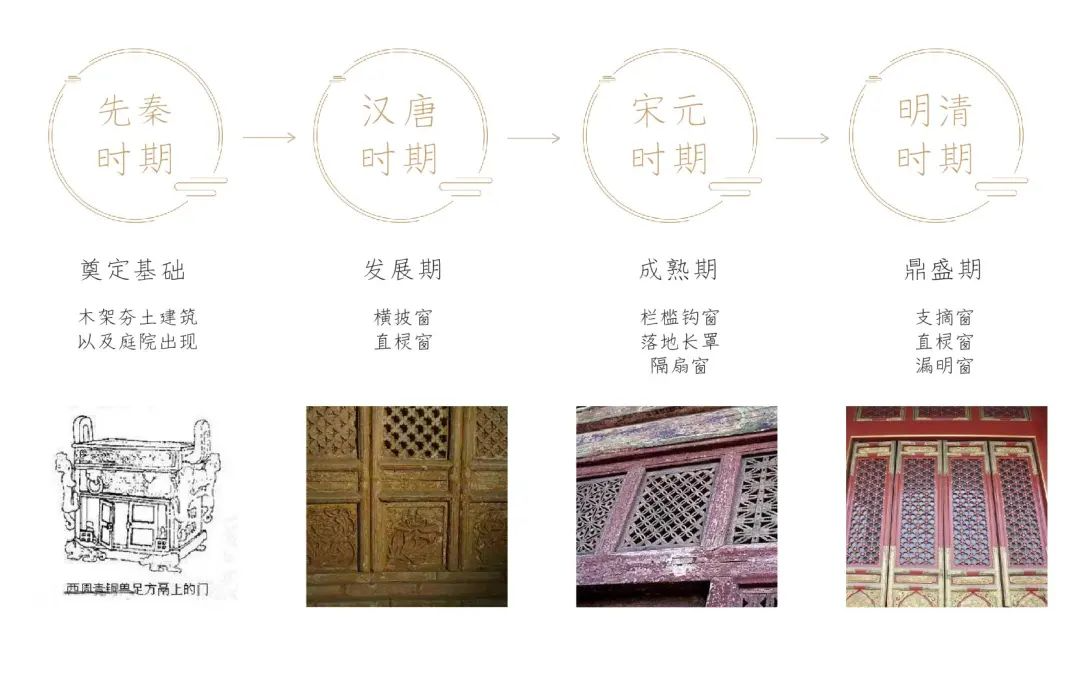The inheritance, integration and evolution of Chinese doors and windows.


In the history of human development, < window > in the form of small holes carved above caves during the cave period to achieve the effect of lighting and ventilation, originally called "chimney". With the progress of human civilization, human beings broke away from cave life and built houses on the ground, and the holes opened in the wall at this time were called "mu".
With the development of society, the house is getting bigger and bigger, in order to make the indoor light and air circulation, the window is opened in front of the house, so it gradually develops into mullioned windows and sills. When people combined lighting, ventilation and decoration, colorful windows came out one after another.

Chinese doors and windows shine in traditional architectural art, and their deep and subtle cultural connotations make people fascinated and linger. The beauty of this artistic conception of oriental life aesthetics is a heartbeat that Chinese can never refuse, all of which comes from the self-confidence of national culture.
Chinese-style door and window structure
◆ Lexin: Also known as diamond flower, the main decorative means of early eaves decoration is the form of diamond flower, also known as lattice eye, is the core of the window and the center of aesthetics.
◆ Tapering board: commonly known as the sleeve ring board, called waist hua board in the Song Dynasty, referred to as waist board, waist hua board can also be written waist flower board, because the word huahua is fake, plus the flower board on the waist, the image is easy to remember; Its position is above and below the skirt, and there are two wipes above and below the skirt, and the plate between the two wipes is called the tapering board.
◆ Skirt board: called water barrier board in Song Shi, the meaning is ominous; There are also those who write barriers, boards of obstacles; And because of its low location, ordinary residents in ancient times would not decorate more, but some residents with good conditions would carve them.
◆ Wipe head: wipe here read mà, Song is called waist string, but slightly different, waist string only refers to the middle part of the horizontal wood, and the upper and lower ends have other names; However, all the horizontal trees on the partition of doors and windows referred to in the Ming and Qing Dynasties are called wiped heads, so there are six wiped heads and five wiped heads; The change of position and style can also add aesthetic effects to the fan and sill.

Chinese door and window type
◆ Mullioned windows
Mullioned windows include broken zi mullioned windows, plate mullioned windows (一馬三arrow windows), 睒 (shǎn) electric windows, and so on. All three types of windows are made by installing wooden strips (mullions) in the upper and lower directions within the window frame.
The section of the mullions is an isosceles right triangle with a right angle outward, which is broken by a square log at an oblique angle, so it is called a broken mullion. The section of the mullions of mullioned windows is usually rectangular in shape, consisting of window frames and vertical arrangement of mullions. Among them, the upper part plus two cross-mullions, the lower part plus three cross-mullions of the plate mullion, also known as "one yard and three arrows".

◆ Pick the window
Supporting window is a kind of window used in residential and residential buildings, which can be supported and taken off the window. The supporting window is divided into two sections, the upper is the support window and the lower is the lifting window. Supporting windows are generally made into two layers, inside and outside. The outer layer of the support window is mullioned windows, or glass is installed to maintain the indoor temperature. The inner layer is made of a drawer. When it's hot, the outer mullioned window can be propped up to allow for air.

◆ Leaky window
A leaky window is a type of window that is more free, but cannot be opened. The leaky window has the function of communicating the interior and exterior scenes, through the leaky window we can see the scenery on the other side, which seems to be separated and looming. Leaky windows developed later, most of them have built-in colorful patterns, which are beautiful attractions in themselves.

◆ Empty window
The difference between empty windows and leaky windows is that empty windows only have window holes and no window mullions, and in architecture, if empty windows belong to "virtual" elements, then leaky windows are "half-real and half-virtual" elements. The setting of empty windows can make several spaces interspersed and penetrate each other, integrate the interior and exterior scenery, and increase the depth of field, expand the space, and obtain a deep and beautiful artistic conception.

◆ Assorted windows
The charm of assorted windows not only comes from its artistic shape, but also from the color and decoration of the window cover, rich brick carving themes, natural flowers and plants, auspicious patterns, etc., the regular and orderly arrangement of the lattice in the center of the window not only gives people a beautiful visual effect, but also gives people a beautiful psychological feeling from the rich meaning it contains.

Features of Chinese doors and windows
The basis of door and window modeling is a rigorous proportional relationship, and the overall shape and local proportions follow the principle of uniformity and coordination. The modeling elements are mainly lines, and the visual perception expressed by the lines makes people feel the beauty of simplicity, simplicity, elegance and generosity.

The doors and windows adopt a very scientific birch structure, < the production method of the edge without >any foreign object connection, which greatly avoids the influence of nature on quality, and today under the premise of maintaining the appearance characteristics, the practice has been greatly simplified.


The decorative techniques such as carving, openwork, inlay, and tracing seem complicated, but they make the doors and windows simple and beautiful as a whole, and the decoration is suitable and decent. And traditional doors and windows are very good at using the characteristics of wood to highlight its natural beauty, such as yellow pear, rosewood, wenge and other high-grade hardwoods are very natural tones and textures, so craftsmen in the production, pay attention to fine workmanship, but will not change the essence of wood.

The historical evolution of ancient doors and windows
For architecture, "doors and windows" are equivalent to the existence of human eyes, even if human beings do not leave home, they can still perceive the changes in the natural world. In the long history, "doors and windows" have undergone inheritance, integration and evolution, and each period has its own unique artistic charm and social meaning in line with the times.
Chinese-style doors and windows have a long history in China, even dating back to Shang and Zhou more than 3,000 years ago. As an integral part of China's ancient splendid architectural civilization, it can be called a brilliant pearl in the treasure house of Chinese culture.

In the pre-Qin period, the earliest large-scale wood-framed rammed-earth buildings and courtyards appeared, resulting in the emergence of specifically defined doors and windows, which at that time did not seek decoration; From the Han and Tang dynasties to the Yuan and Song dynasties, the art of window decoration was in a period of development and maturity, and doors and windows were gradually standardized, and practicality and decoration coexisted.
After the Ming and Qing Dynasties, door and window culture has become an important category of architectural decorative art, full of secular character stories and flowers and animals have become decorative themes, and craftsmen spare no effort to exert their imagination, which is the golden age of door and window art culture.
Modern doors and windows
In modern society, early doors and windows were still wooden windows with wood as the main material, and then painted with natural wood paint and pasted with paper, which played a role in lighting and wind protection. In the later stage, glass was applied, and on the basis of the wooden frame, the glass was directly embedded in the window frame, which not only continued the role of lighting and wind blocking, but also had a weak wind blocking effect of "paper paste window".





Some of the graphic information comes from the Internet, if there is any infringement, please inform us, we will immediately delete the relevant content














First, please LoginComment after ~